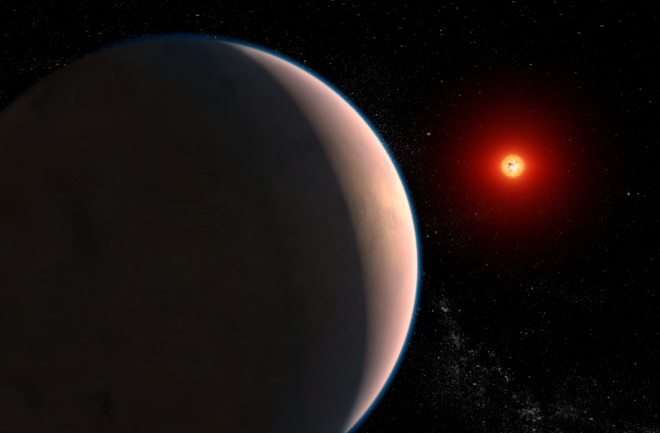The James Webb Space Telescope may have discovered water on super-Earth GJ 486 b, a groundbreaking find that could reshape our understanding of exoplanet atmospheres and potential habitability.

Table of Contents
A Groundbreaking Discovery: Water on Super-Earth GJ 486 b
In a groundbreaking discovery that has sent ripples through the scientific community, the James Webb Space Telescope (JWST) may have found the first evidence of a rocky exoplanet with water on super-Earth GJ 486 b. This discovery is significant because it could potentially change our understanding of the conditions necessary for an exoplanet to maintain an atmosphere.
Watch it as a video instead of reading:
Mars Declared Unsafe For Humans: No one can survive for longer than four years
The Unusual Exoplanet
The exoplanet in question, GJ 486 b, is a super-Earth that orbits a red dwarf star in the Virgo constellation, located 26 light-years away from us. This exoplanet is unusual in many ways. It is about 30% larger than Earth and three times as massive, indicating a rocky world with stronger gravity than our home planet. The planet orbits its red dwarf star in just under 1.5 Earth days and is believed to be tidally locked, possessing a permanent day side and a permanent night side.

However, its close proximity to its star means it lies well outside the habitable zone, with surface temperatures reaching a scorching 800 degrees Fahrenheit. This extreme heat makes the presence of water vapor in its atmosphere all the more surprising.
The Hunt for Water Vapor
Despite the extreme heat, JWST’s Near-Infrared Spectrograph (NIRSpec) detected hints of water on super-Earth GJ 486 b. This discovery is significant because while water vapor has been observed on gaseous exoplanets before, no atmosphere has been definitively detected around a rocky exoplanet.
The detection of water on super-Earth GJ 486 b, a rocky exoplanet, is a major breakthrough for exoplanet science. It suggests that even in harsh environments, rocky exoplanets may be able to maintain or re-establish an atmosphere. However, the research team urges caution, as the water vapor could be emanating from the star itself, specifically from cool starspots, rather than the planet.
The Mystery of the Water Source
The presence of water on super-Earth GJ 486 b could potentially indicate an atmosphere, but it is equally plausible that the water vapor originates from the star itself. Starspots, which are cooler, darker areas on the surface of a star, can harbor water molecules. GJ 486 b’s host star is much cooler than the Sun, which means that even more water vapor could concentrate within its starspots, potentially creating a signal that mimics a planetary atmosphere.
This raises a significant and unresolved question in astronomy: can a rocky planet maintain or reestablish an atmosphere in such a harsh environment? The answer to this question could significantly impact our understanding of rocky exoplanets and their potential to maintain atmospheres in harsh environments.
The Role of Volcanic Activity
If a water vapor atmosphere does exist on GJ 486 b, it would be expected to gradually erode due to stellar heating and irradiation. Consequently, if an atmosphere is present, it would likely need to be continuously replenished. One possible source of replenishment could be volcanic activity.
Volcanoes could eject steam from the planet’s interior, replenishing the atmosphere with water vapor. This scenario would suggest a geologically active planet, with implications for its internal structure and history. It would also raise intriguing questions about the potential for life in harsh environments.
Future Observations
To determine whether the water vapor is indeed in the planet’s atmosphere, additional observations are required to assess the amount of water present. Future observations using the JWST’s Mid-Infrared Instrument (MIRI) may provide further insight into this system.
If the planet has no atmosphere or only a thin one, the hottest part ofthe day side should be directly under the star. However, if the hottest point is shifted, this would suggest the presence of an atmosphere capable of circulating heat. This would be a significant finding, as it would indicate that the planet has a dynamic atmosphere capable of redistributing heat, a characteristic of many planets in our own solar system.
The Implications of the Discovery
The discovery of water on super-Earth GJ 486 b, a rocky exoplanet with an atmosphere, would be a significant breakthrough in the field of exoplanet science. It would not only shed light on the diversity of exoplanet atmospheres but also raise intriguing questions about the potential for life in harsh environments.
The presence of water is considered a key factor in determining a planet’s potential habitability. Water serves as a solvent for biochemical reactions and regulates temperature in living organisms. Therefore, the discovery of water vapor in the atmosphere of a rocky exoplanet could have profound implications for our understanding of where life could exist in the universe.
The Role of the James Webb Space Telescope
The James Webb Space Telescope (JWST), named after the former NASA administrator James E. Webb, is a large, infrared-optimized space observatory developed through a collaboration between NASA, the European Space Agency (ESA), and the Canadian Space Agency (CSA). The telescope is designed to succeed the Hubble Space Telescope as the premier space observatory of the next decade, offering significant advancements in terms of sensitivity and capabilities.
The main scientific goals of the JWST include investigating the formation of the first galaxies, stars, and black holes in the early universe, observing the formation of stars and planetary systems, and understanding the conditions necessary for the emergence of life. The JWST is equipped with a 6.5-meter (21.3 feet) primary mirror, significantly larger than Hubble’s 2.4-meter (7.9 feet) mirror, allowing it to capture more light and achieve much higher resolution. Its instruments are optimized for infrared wavelengths, which enables it to peer through dust and gas to observe distant celestial objects and study the early universe.
Conclusion
As scientists continue to study the water on super-Earth GJ 486 b, the results of these observations could significantly impact our understanding of rocky exoplanets and their potential to maintain atmospheres in harsh environments. The discovery of water vapor in the atmosphere of a rocky exoplanet would be a significant breakthrough in the search for extraterrestrial life. While no such planet has been found yet, the growing catalogue of exoplanets and advancements in detection techniques continue to bring us closer to answering the profound question of whether or not we are alone in the universe.
Reference(s):

